Aristide Cavaillé-Coll
| Aristide Cavaillé-Coll | |
|---|---|
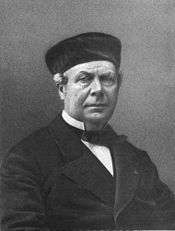 | |
| Born |
4 January 1811 Montpellier, France |
| Died |
13 October 1899 (aged 88) Paris, France |
Aristide Cavaillé-Coll (French: [aʁistid kavaje kɔl]; 4 February 1811 – 13 October 1899), was a French organ builder. He has the reputation of being the most distinguished organ builder of the 19th century.[1] He pioneered innovations in the art and science of organ building that permeated throughout the profession and influenced the course of organ building and organ composing through the early 20th century. The organ reform movement sought to return organ building to a more Baroque style; but since the 1980s, Cavaillé-Coll's designs have come back into fashion. After Cavaillé-Coll's death, Charles Mutin maintained the business into the 20th century. Cavaillé-Coll was the author of many scientific journal articles and books on the organ in which he published the results of his researches and experiments. He was the inventor of several organ sounds/ranks/stops such as the flûte harmonique.
Life
Born in Montpellier, France, to Dominique, one in a line of organ builders, he showed early talent in mechanical innovation. He exhibited an outstanding fine art when designing and building his famous instruments. There is a before and an after Cavaillé-Coll. His organs are "symphonic organs": that is, they can reproduce the sounds of other instruments and combine them as well. His largest and greatest organ is in Saint-Sulpice, Paris. Featuring 100 stops and five manuals, this magnificent instrument, which unlike many others remains practically unaltered, is a candidate to become a UNESCO World Heritage Site.
Cavaillé-Coll was also well known for his financial problems. The art of his handcrafted instruments, unparalleled at that time, was not enough to ensure his firm's survival. It was inherited in 1898, shortly before his death in Paris, by Charles Mutin. He continued in the organ business, but by World War II the firm had almost disappeared.
Organ building innovations
Cavaillé-Coll is responsible for many innovations that revolutionized organ building, performance and composition. Instead of the Positif, Cavaillé-Coll placed the Grand-Chœur manual as the lowest manual, and included couplers that allowed the entire tonal resources of the organ to be played from the Grand-Chœur. He refined the English swell box by devising a spring-loaded (later balanced) pedal with which the organist could operate the swell shutters, thus increasing the organ's potential for expression. He adjusted pipemaking and voicing techniques, thus creating a whole family of stops imitating orchestral instruments such as the bassoon, the oboe and the english horn. He popularized the harmonic flute stop, which, together with the montre, the gambe and the bourdon, formed the fonds (foundations) of the organ. He introduced divided windchests which were controlled by ventils. These allowed the use of higher wind pressures and for each manual's anches (reed stops) to be added or subtracted as a group by means of a pedal. Higher wind pressures allowed the organ to include many more stops of 8' (unison) pitch in every division, so complete fonds as well as reed choruses could be placed in every division, designed to be superimposed on top of one another. Sometimes he placed the treble part of the compass on a higher pressure than the bass, to emphasize melody lines and counteract the natural tendency of small pipes (especially reeds) to be softer.
| “ | It is he [Cavaillé-Coll] who conceived the diverse wind pressures, the divided windchests, the pedal systems and the combination registers; he who applied for the first time Barker's pneumatic motors, created the family of harmonic stops, reformed and perfected the mechanics to such a point that each pipe—low or high, loud or soft—instantly obeys the touch of the finger… From this result: the possibility of confining an entire division in a sonorous prison—opened or closed at will—the freedom of mixing timbres, the means of intensifying them or gradually tempering them, the freedom of tempos, the sureness of attacks, the balance of contrasts, and, finally, a whole blossoming of wonderful colors—a rich palette of the most diverse shades: harmonic flutes, gambas, bassoons, English horns, trumpets, celestes, flue stops and reed stops of a quality and variety unknown before. | ” |
| — Charles-Marie Widor, Avant-propos to the organ symphonies, tr. John Near | ||
For a mechanical tracker action and its couplers to operate under these higher wind pressures, pneumatic assistance provided by the Barker lever was required, which Cavaillé-Coll included in his larger instruments. This device made it possible to couple all the manuals together and play on the full organ without expending a great deal of effort. He also invented an ingenious pneumatic combination action system for his five-manual organ at Église Saint-Sulpice, Paris. All these innovations allowed a seamless crescendo from pianissimo all the way to fortissimo, something never before possible on the organ. His organ at the Basilique Ste-Clotilde, Paris (proclaimed a basilica by Pope Leo XIII in 1897) was one of the first to be built with several of these new features. Consequently, it influenced César Franck, who was the titular organist there. The organ works of Franck have inspired generations of organist-composers who came after him.
Legacy
Marcel Dupré stated once that "composing for an orchestra is quite different from composing for an organ... with exception of Master Cavaillé-Coll's symphonic organs: in that case one has to observe an extreme attention when writing for such kind of majestic instruments." Almost a century beforehand, César Franck had ecstatically said of the rather modest Cavaillé-Coll instrument at l'Eglise St.-Jean-St.-François in Paris with words that summed up everything the builder was trying to do: "Mon nouvel orgue ? C'est un orchestre !" ("My new organ? It's an orchestra!"). Franck later became organist of a much larger Cavaillé-Coll organ at Ste. Clotilde in Paris. In 1878 Franck was featured recitalist on the four-manual Cavaillé-Coll organ at the Palais du Trocadéro in the Trocadéro area of Paris; this organ was subsequently rebuilt by V. & F. Gonzalez in 1939 and reinstalled in the Palais de Chaillot which replaced the Palais de Trocadéro, then rebuilt in 1975 by Danion-Gonzalez and relocated to the Auditorium Maurice Ravel in Lyon. Franck's Trois Pièces were premiered on the Trocadéro organ.
Film
A documentary film titled The Genius of Cavaillé-Coll was released in 2012 by Fugue State Films to mark both the 200th anniversary of Cavaillé-Coll's birth in 2011 and the 150th anniversary of his organ at St Sulpice.[2] It won the DVD Documentary Award of the BBC Music Awards 2014.[3]
Existing Cavaillé-Coll organs
For a complete list of all organs by Cavaillé-Coll, see: List of Organs by Aristide Cavaillé-Coll
In Europe
In France
- Bonsecours: Basilique Notre-Dame de Bonsecours
- Caen: Église Saint Etienne
- Carcassonne: St. Michel's Cathedral
- Castelnau-d'Estrétefonds : St.Martin's church
- Épernay: Saint-Pierre Saint-Paul church
- Luçon: Cathedral of Luçon, Vendee[4]
- Lyon: Church of St. François-de-Sales, Lyon
- Orléans: Cathedral of the Holy Cross (Cathédrale du Saint-Croix - since slightly modified by Haerpfer)
- Mazamet: Eglise Saint-Sauveur
- Nancy: Cathedral (65 stops, 4 manuals)
- Paris: American Cathedral in Paris
- Paris: Église Saint-Roch
- Paris: Église de la Madeleine (since rebuilt and modified by Gonzalez)
- Paris: Notre-Dame-de-la-Croix
- Paris: Notre Dame de Paris (modified)
- Paris: Pentemont Abbey[5]
- Paris: Saint-Antoine-des-Quinze-Vingts[6]
- Paris: Saint Clotilde Basilica (extensively modified, rebuilt by Dargassies in 2004)
- Paris: Saint-Sulpice (by François-Henri Clicquot, reconstructed and improved by Cavaillé-Coll)
- Paris: Saint Vincent de Paul
- Paris: Sainte-Trinité
- Paris: Église Saint-Jean-de-Montmartre (moved from École Sacré-Cœur de la Ferrandière, Lyon)
- Paris: Basilique du Sacré-Cœur, Paris
- Paris: Val-de-Grâce chapel organ
- Courbevoie (near Paris): Église Saint-Maurice de Bécon [7]
- Perpignan: Cathedral
- Rouen: Church of St. Ouen
- Saint-Denis: St. Denis
- Saint-Omer: de St Omer
- Saint-Yrieix-la-Perche : Collégiale du Moustier
- Toulouse: Saint-Sernin Basilica
- Trouville-sur-Mer: Église Notre-Dame des Victoires
- Lavaur: Saint-Alan Cathedral
- Rabastens: Notre-Dame-du-Bourg Church (smallest, with 20 stops) near Cavaillé-Coll dynasty cradle town of Gaillac
The organ of St. Ouen de Rouen is believed to be completely unmodified in any way (save for normal maintenance) since its completion, and is frequently recorded as an example of "pure" Cavaillé-Coll sound.
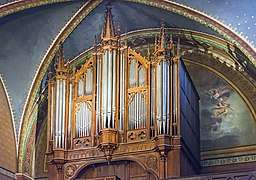 Orgues in Castelnau-d'Estrétefonds
Orgues in Castelnau-d'Estrétefonds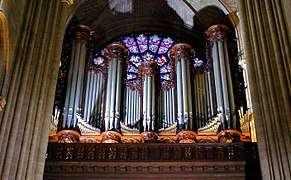 Orgues in Notre Dame de Paris
Orgues in Notre Dame de Paris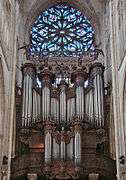 Church of Saint Ouen, Rouen
Church of Saint Ouen, Rouen Rennes Cathedral
Rennes Cathedral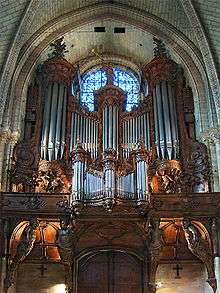 Angers Cathedral
Angers Cathedral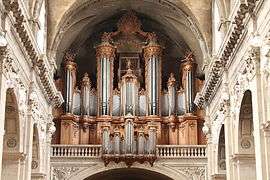
In Spain
- Lekeitio: Basílica de la Asunción de Nuestra Señora (Lekeitio)
- Madrid: Basílica de San Francisco el Grande
- Alegia: San Juan
- Azkoitia: Santa María
- Azpeitia: Basílica de Loyola
- Bilbao: Santa María de Begoña
- Getaria (Guetaria): San Salvador
- Irún: Santa María
- Mutriku (Motrico): Santa Catalina
- Oiartzun: San Esteban
- Pasaia (Pasajes)
- San Sebastián (Donostia): Résidence de Zorroaga
- San Sebastián (Donostia): San Marcial d’Altza
- San Sebastián (Donostia): Santa María del Coro
- San Sebastián (Donostia): Santa Teresa
- San Sebastián (Donostia): San Vicente
- Urnieta: San Miguel
- Vidania (Bidegoyan), San Bartolomé
In the United Kingdom
In the Netherlands
In Belgium
- Brussels: Royal Conservatory of Music
- Ghent: Saint Nicholas' Church, Ghent (1856)
- Leuven: Jesuit Church Heverlee (1880)
- Leuven: Saint Joseph's Church (1880)
- Hasselt: Sacred Heart Church (1878)
- Gesves : Saint Maximin (1871)
In Portugal
- Lisbon, Portugal: Igreja de São Luís dos Franceses
- Lisbon, Portugal: Igreja de São Mamede - donated by the Dukes of Palmela in 1956
In Italy
- Rome, Italy: Chapel of the Casa Santa Maria of the Pontifical North American College
In addition, Cavaillé-Coll designed a large but never-built pipe organ for Saint Peter's Basilica, where a 1/10 scale model is preserved.[9]
In Denmark
- Copenhagen, Denmark: Jesus Church (1890)[10]
In Russia
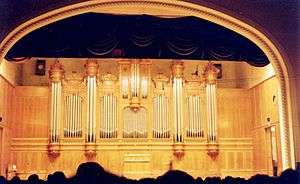
- Moscow, Russia: Bolshoi Hall of Moscow Conservatory, Russia (installed by Charles Mutin)
In Latin America
In Venezuela
- Caracas: Iglesia de la Parroquia San Francisco. Used for regular service.
- Caracas: Iglesia de la Parroquia Altagracia (Inoperative)
- Caracas: Iglesia de la Parroquia Santa Teresa. Used for regular service.
- Caracas: Iglesia de la Parroquia San José (In a delicate situation)
- Caracas: Parroquia La Encarnación del Valle. After several decades of silence, it's been played regularly since in 2011.
- Los Teques: Catedral (Inoperative)
In Brazil
- São Paulo - SP: Igreja de São José do Ipiranga (1863)
- São Paulo - SP: Igreja do Senhor Bom Jesus do Brás (1875)
- Rio de Janeiro - RJ: Capela da Santa Casa (1882)
- Itu - SP: Igreja Matriz Nossa Senhora da Candelária (1882)
- Belém - PA: Catedral da Sé (1882)
- Campinas - SP: Catedral Metropolitana (1883)
- Salvador - BA: Igreja da Ordem Terceira do Carmo (1888)
- Lorena - SP: Catedral Nossa Senhora da Piedade (1889)
- Campo Largo - PR: Igreja Matriz de Nossa Senhora da Piedade (1892)
- Jundiaí - SP: Catedral de Nossa Senhora do Desterro (1895)
- Rio de Janeiro - RJ: Igreja Nossa Senhora do Carmo da Lapa (1898)
- Rio de Janeiro - RJ: Capela do Colégio Sion do Cosme Velhos (Mutin)
- Rio de Janeiro - RJ: Igreja de Nossa Senhora de Bonsucesso (Mutin)
In Mexico
- Mazatlán, Mexico: Catedral Basílica de la Inmaculada Concepción
In Chile
- Valparaíso, Chile: Iglesia de los Sagrados Corazones (French Fathers Church) (1872)
In Argentina
- Lujan, Basilica de Lujan.
- Basílica del Santísimo Sacramento (1912) Bs As
- Capilla del Colegio "La Salle" (1926)
- Iglesia de San Juan Bautista (ca. 1920)
- Basílica del Sagrado Corazón de Jesús (ca. 1906)
- Basílica de San Nicolás de Bari (órgano principal) (fecha incierta de construcción)
- Basílica de San Nicolás de Bari (órgano de la cripta)
- Capilla de la "Casa de la empleada"
- Parroquia de "Nuestra Señora del Valle"
- Parroquia de "San Martín de Tours" (ca. 1910)
- Parroquia de "San Cristobal"
- Catedral de San Isidro (1906)
- Parroquia de "Nuestra Señora de Aránzazu" (San Fernando) (1907)
- Parroquia de "San Francisco Solano" (Bella Vista) (1906)
In Japan
Asteroid
Cavaillé-Coll's name was given to an asteroid: 5184 Cavaillé-Coll.
Further reading
- Bicknell, Stephen. Cavaillé-Coll's Four Fonds
- Cavaillé-Coll, Cécile (1929). Aristide Cavaillé-Coll: Ses Origines, Sa Vie, Ses Oeuvres. Paris: Fischbacher.
- Douglass, Fenner (1999). Cavaillé-Coll and the French Romantic Tradition. New Haven: Yale University Press.
- Huybens, Giblert (1985). Cavaillé-Coll: Liste des travaux exécutés/Werkverzeichnis. Lauffen/Neckar: Orgelbau-Fachverlag Rensch. ISBN 3-921848-12-1.
References
- ↑ Snyder, Kerala J. (August 2002). "Aristide Cavaillé-Coll: Master of Masters". The Organ as A Mirror of Its Time. Oxford University Press. ISBN 9780195144154. Retrieved November 11, 2014.
- ↑ Fraser, Will (December 2011). "Recording the organs of Cavaillé-Coll". The Organists' Review: 14–21.
2011 is the 200th anniversary of Aristide Cavaillé-Coll’s birth. 2012 is the 150th anniversary of the completion of his organ at St Sulpice...as such, we decided to make a documentary about him to mark the anniversaries of 2011 and 2012.
- ↑ "BBC Music Magazine Awards 2014 winners announced". BBC Music Magazine. Immediate Media Company Limited. 2014-04-08. Archived from the original on 2014-04-14. Retrieved 2014-08-29.
...The Genius of Cavaillé-Coll, an epic exploration of the legendary French organ builder, won the DVD Documentary Award...announced today at a ceremony that took place at Kings Place in London.
- ↑ oeust france. "Quel avenir pour le grand orgue de Luçon ?". ouest-france.fr. Retrieved 22 October 2015.
- ↑ "Temple Pentemont". Organs of Paris.
- ↑ "L'orgue Cavaillé-Coll".
- ↑ "Amis de l'Orgue Cavaillé-Coll de Saint-Maurice de Bécon" [Friends of the Cavaillé-Coll Organ of Saint-Maurice de Bécon] (in French). Archived from the original on 2014-05-17. Retrieved 2014-08-29.
- ↑ Verburg, Mel. "Amsterdam, Parochieel Centrum Sint Augustinus / Verzorgingscentrum 'Nieuw Vredenburg' (Postjesweg)" [Amsterdam, parochial center of Saint Augustine]. Orgelsite (in Dutch). Archived from the original on 2014-03-13. Retrieved 2014-08-29.
- ↑ Ebrecht, Ronald (2012). Cavaillé-Coll's Monumental Organ Project for Saint Peter's, Rome: Bigger Than Them All. Lanham: Lexington Books. ISBN 978-0-7391-6728-1.
- ↑ "Jesuskirkens orgler" [Jesus Church Organs]. Jesuskirken - Valby Sogn (in Norwegian). Archived from the original on 2014-08-29. Retrieved 2014-08-29.
- ↑ "Pipe Organ at Haus Sonnnenchein. 歴史あるパイプオルガン" [History of the Pipe Organ at Haus Sonnnenchein] (in Japanese). Archived from the original on 2012-03-08. Retrieved 2014-08-29.
External links
| Wikimedia Commons has media related to Aristide Cavaillé-Coll. |